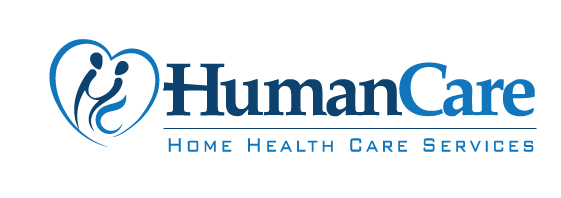How to Prevent Medication Errors in Home Care
Ensuring Medication Safety: A Comprehensive Guide for Home Care Providers

Introduction
Medication errors pose significant risks in home care settings, affecting patient safety and healthcare costs globally. With vulnerable populations often receiving care outside traditional medical facilities, understanding and mitigating these risks is imperative. This article delves into the causes and types of medication errors, strategic interventions for prevention, and the importance of caregiver roles and training in fostering a safe medication management environment at home.
Understanding Medication Errors: Types and Causes
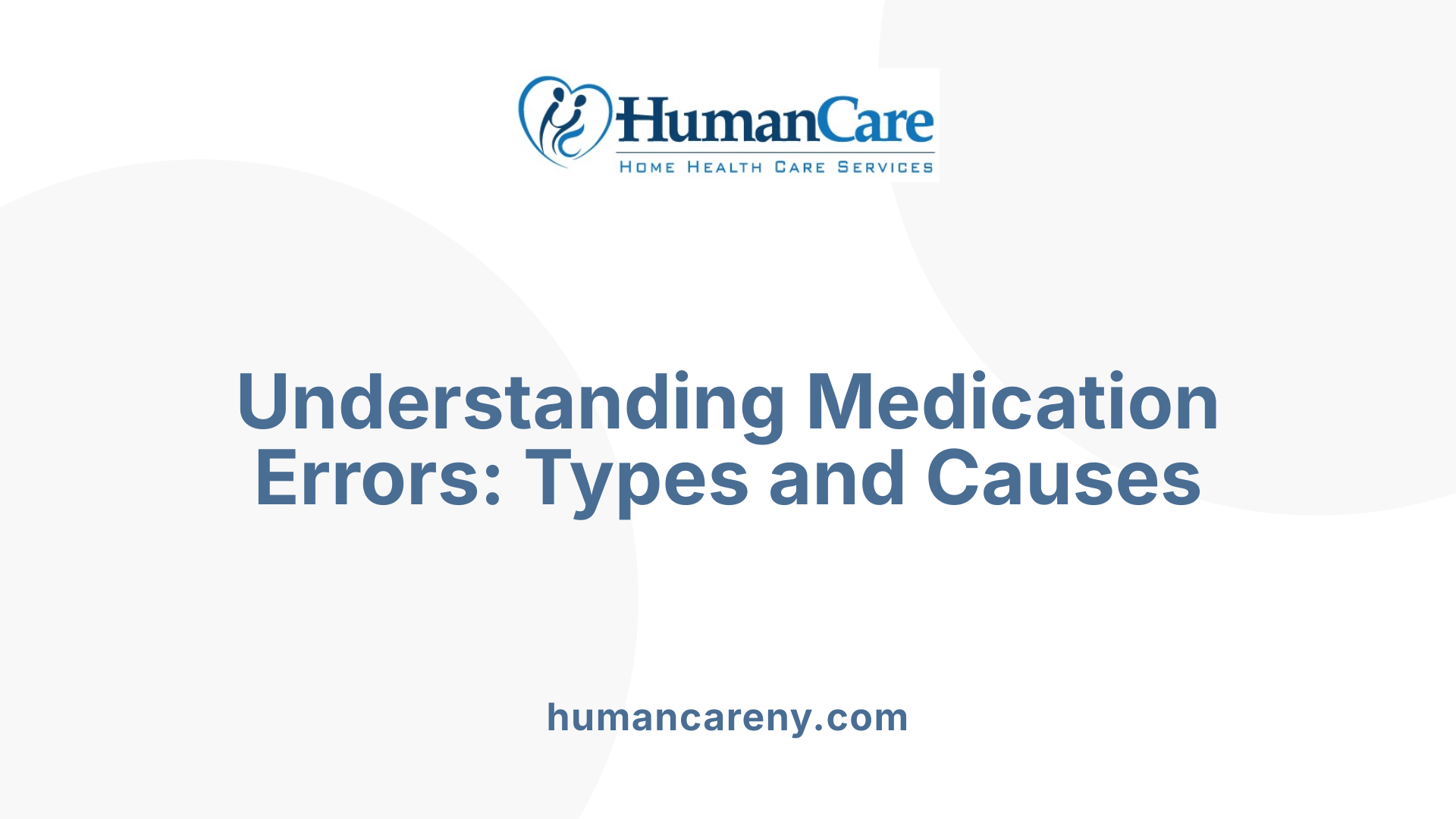
What types of medication errors are most common and what causes them?
Medication errors are prevalent in various stages of the medication process, particularly in home care settings. These errors can originate during prescribing, dispensing, administration, and monitoring phases. The types of medication errors frequently reported include:
- Administration Mistakes: Account for roughly 22% of global medication errors, leading to significant patient risk.
- Dose Errors: These occur when the patient receives an incorrect dose of medication.
- Route Errors: Administering medication via the wrong route can compromise efficacy.
- Frequency Errors: Missing or improperly timing doses can lead to treatment failures.
- Substitution Errors: Replacing one drug with another, often because of confusion or lack of information.
Common factors contributing to these errors are multifactorial. Human errors, including fatigue or pacing during administration, often lead to lapses in judgment. Poor communication among caregivers and healthcare providers also plays a significant role, often exacerbated by language barriers or low health literacy in caregivers.
Additionally, systemic issues like overwhelming workloads and complex medication regimens contribute to errors. Illegible prescriptions or misunderstanding of directions further complicate medication adherence. These errors can result in severe consequences, impacting over 1.5 million individuals annually in the U.S. and burdening the healthcare system with billions of dollars in avoidable costs.
In home care, the combination of polypharmacy, inadequate caregiver training, and unregulated settings increases the risks of medication errors, underscoring the need for improved practices in this domain.
Strategies to Prevent Medication Errors in Home Care
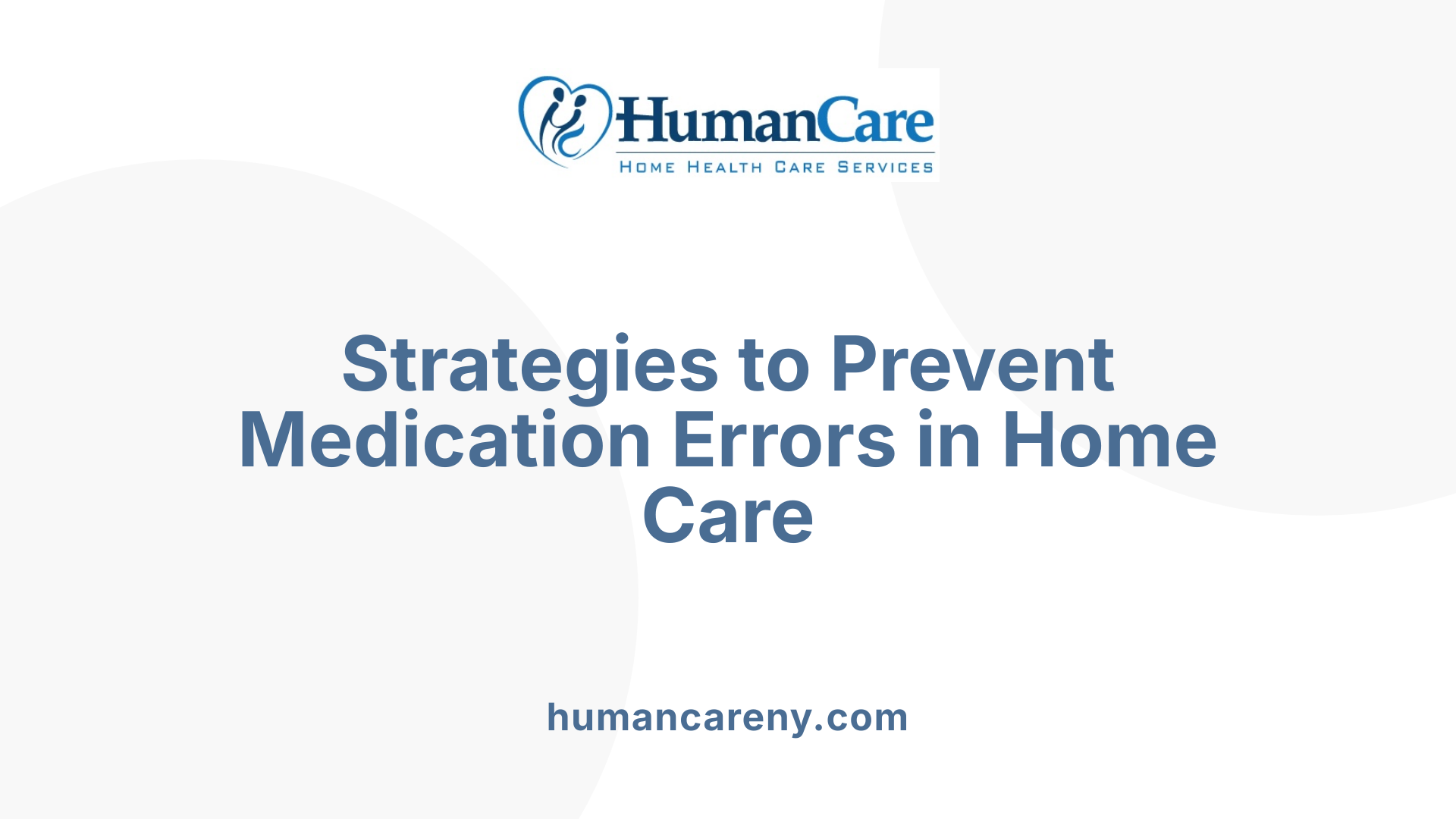
What are effective strategies to prevent medication errors in home care settings?
Medication administration mistakes can lead to severe health issues, particularly in home care environments. To combat this, effective strategies are essential.
Improving Prescribing Practices: Providers should simplify prescribing protocols to reduce complexity. This includes using clear language and limiting the number of medications when possible.
Health Literacy and Engagement: Utilizing health literacy-informed counseling techniques, such as teach-back and show-back methods, engages caregivers more directly, ensuring they understand medication instructions fully.
Utilization of Standardized Dosing Tools: Employing dosing tools designed specifically for accurate measurements helps eliminate errors that can arise from using household items that may not accurately measure liquid medications.
Regular Medication Reconciliation: It is crucial to conduct regular medication reconciliations at every clinical encounter. This process ensures that caregivers maintain an accurate list of all medications, which includes prescription medications, over-the-counter drugs, and supplements.
Involving Patients and Families: Engaging adolescents and adult caregivers in the medication management process can foster a sense of responsibility and awareness, which is vital for adherence.
Safe Disposal Practices: Educating caregivers on proper disposal methods for medications helps prevent accidental administration or misuse, contributing to overall safety.
Leveraging Technology: The use of electronic health records and medication management systems can support caregivers in managing medications safely. This technology can alert caregivers about potential errors and ensure they have the current medication list readily available.
Fostering a culture of communication and education is paramount in mitigating medication errors in home care settings. By equipping caregivers with the right tools and knowledge, the risk of errors can be significantly reduced.
The Role of Caregivers in Medication Safety
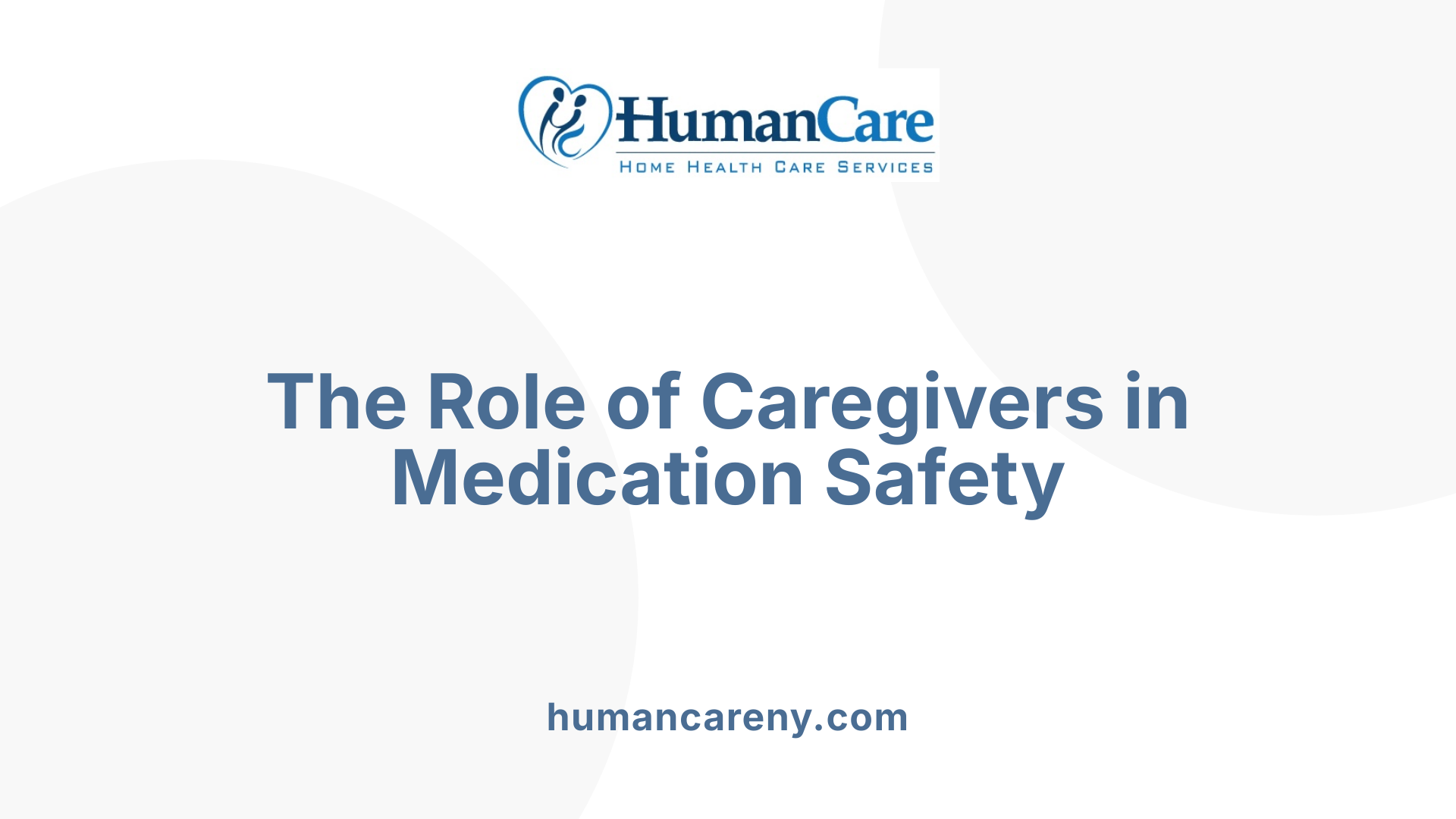
What role do caregivers play in managing medication safely?
Caregivers are essential to ensuring medication safety within home care settings. They hold significant responsibilities that directly impact patient health, particularly for children and elderly patients with chronic conditions who may require complex medication regimens.
To manage medications effectively, caregivers must be knowledgeable about the medications being administered. This includes recognizing potential side effects and understanding terminology associated with medication errors and adverse drug reactions. By being informed, caregivers become advocates for safe medication practices.
How can caregivers ensure adherence to prescribed regimens?
To prevent mistakes and ensure adherence, caregivers can implement several practical strategies:
- Maintain a comprehensive medication list: Keeping an updated list helps track what medications are being taken, preventing double dosing or missed doses.
- Utilize pillboxes: Organizing medications into daily or weekly pillboxes can simplify administration and clarify dosage schedules.
- Create routines linked to daily activities: Associating medication times with daily activities helps reinforce adherence, making it less likely for caregivers to forget.
The importance of communication for safety
Effective communication between caregivers and healthcare providers is vital. Regular discussions with healthcare professionals enable caregivers to understand medication instructions better and address any concerns about potential drug interactions or side effects. This dialogue is especially crucial for older adults, who may suffer from polypharmacy, further complicating their treatment plans.
Training caregivers in health literacy-informed strategies can greatly enhance their confidence and capability in handling medications safely. Overall, ensuring caregiver education and support is pivotal in promoting better health outcomes and fostering safe medication management in home settings.
Regular Training: A Pillar of Medication Safety
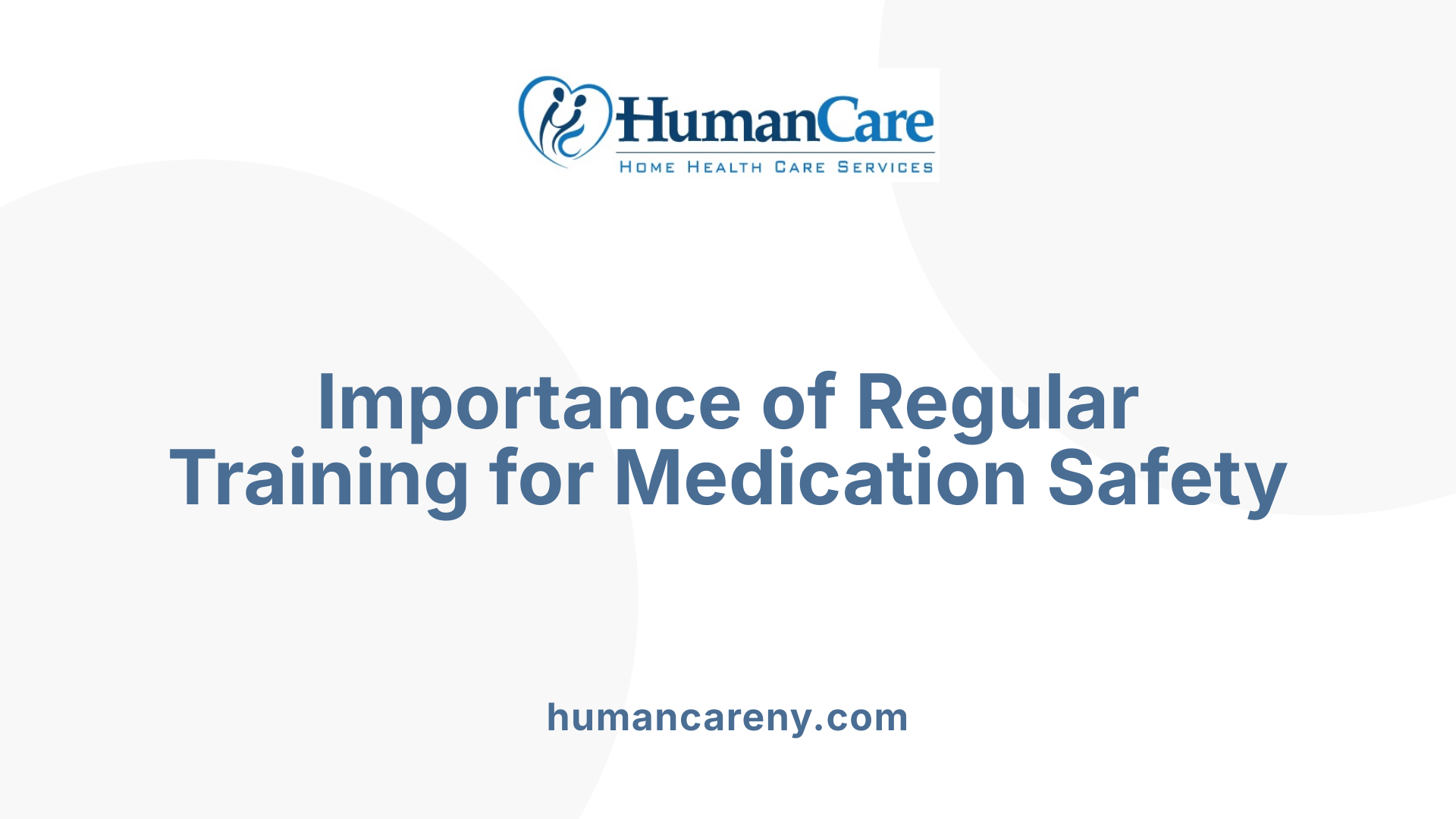
Why is regular training important for medication safety?
Regular training plays a critical role in enhancing medication safety across healthcare settings. It empowers healthcare professionals to identify and prevent medication-related errors, which can lead to serious patient harm, including morbidity and mortality. In fact, the U.S. experiences over 7,000 fatalities annually due to such errors. Ongoing education addresses challenges like excessive workloads and inadequate staffing, which can jeopardize patient safety.
Training initiatives such as TeamSTEPPS focus on improving teamwork and communication, essential factors in reducing medication administration errors (MAEs), particularly within high-risk environments. The five rights of medication administration—right drug, right dose, right route, right time, and right person—are pivotal principles that staff learn to incorporate in their practice. By reinforcing these key practices, healthcare professionals are better equipped to ensure patients receive the appropriate treatments.
Furthermore, fostering a culture of safety through continuous training encourages staff to report errors and near-misses without fear of retribution, ultimately enhancing accountability and learning within the organization.
What is the impact of training on error rates?
Research shows a strong correlation between regular training and reduced medication error rates. Nurses who have participated in training within the last two years are nearly twice as likely not to commit medication-related errors. Regular training also improves the use of safety protocols, such as the double-check principle (DCP), which significantly lowers error risk by allowing colleagues to verify each other's work.
The importance of structured training programs cannot be overstated, especially tailored for informal caregivers and nursing staff, who are often at greater risk of making mistakes due to lack of experience or training.
In summary, ongoing education not only enhances individual competency but strengthens the overall medication management system in healthcare settings. By ensuring that staff members maintain a current understanding of medication safety, organizations can significantly mitigate risks associated with medication errors.
Interventions for Informal Caregivers
What role do caregivers play in managing medication safely?
Informal caregivers play a critical role in managing medications for those they support, particularly in home care settings. However, they often face significant challenges that can lead to medication errors. Commonly reported mistakes by caregivers include missed doses and confusion regarding when and how to administer medications. This highlights the pressing need for structured systems and support to reduce these avoidable errors.
Challenges for informal caregivers
The challenges faced by informal caregivers are multifaceted. Many receive little to no formal training, which can leave them ill-equipped to handle medication management intricacies. Furthermore, factors such as language barriers, low health literacy, and competing responsibilities can increase the risk of errors. These can particularly impact caregivers who manage complex medication regimens for patients with chronic conditions.
Training interventions
To address these challenges, tailored training interventions are essential. Training programs focused on medication administration and error recognition can significantly improve caregivers’ effectiveness and confidence. For example, hands-on demonstrations, teach-back methods, and pictorial educational materials can enhance understanding and adherence to medication routines.
Considering that qualified caregivers with extensive training tend to report fewer errors, implementing ongoing educational initiatives can help create a safer home care environment. Regular training sessions and refresher courses may reduce medication-related mistakes and improve overall health outcomes for patients in their care.
Leveraging Technology for Medication Management
How are electronic health records utilized in medication management?
Electronic health records (EHRs) play a crucial role in enhancing medication management, particularly within home care settings. By maintaining comprehensive patient medication histories, EHRs facilitate regular medication reconciliations, ensuring that healthcare providers have up-to-date information. This helps prevent errors such as missed doses or incorrect medications during transitions of care.
Moreover, EHRs allow for the tracking of medication adherence and potential drug interactions, alerting caregivers and healthcare providers to risks. With real-time access to medication records, caregivers can be more informed and proactive, thus minimizing the likelihood of errors that can lead to adverse drug events.
What are dosing tools and their importance?
Dosing tools are essential for the precise measurement of liquid medications, particularly in pediatric care where accurate dosing is critical. Tools designed for this purpose include oral syringes, dosing cups, and medication spoons. By utilizing standardized and easy-to-read dosing tools, caregivers can significantly reduce the risk of administering incorrect dosages.
These tools support caregivers' understanding, especially those with lower health literacy, and directly impact medication safety. The use of these tools should be emphasized in caregiver education programs, alongside guidelines on their proper use.
| Technology Benefits | Electronic Health Records (EHRs) | Dosing Tools |
|---|---|---|
| Medication history access | Centralized, real-time updates on medications | Accurate dosing |
| Prevent errors | Reduces missed doses and prescription errors | Minimized administration errors |
| Improved communication | Eases collaboration among healthcare providers | Enhances caregiver confidence |
| Alerts for adverse effects | Potential interactions and allergies | Supports health literacy |
Creating a Culture of Safety Through Communication
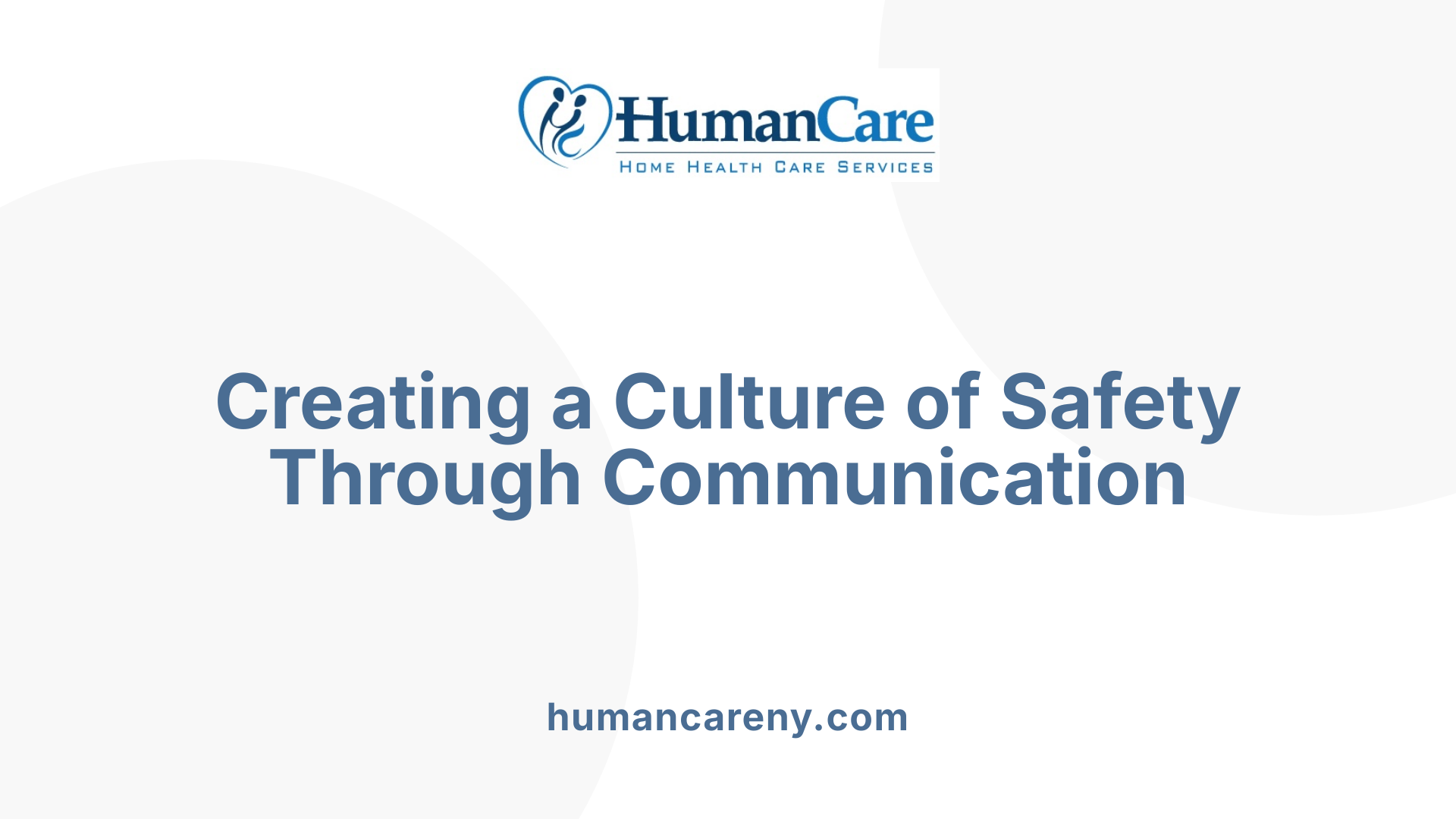
Communication among caregivers and healthcare providers
Effective communication is critical in home care settings to minimize medication errors. Caregivers often juggle multiple medications, and any lack of clarity can lead to serious mistakes. For instance, when caregivers can easily discuss medication changes with healthcare providers, it reduces confusion and improves adherence.
Engaging both caregivers and patients in discussions about medication regimens fosters an environment where questions are encouraged. This is particularly important for caregivers with limited health literacy or language barriers. Training staff to use health literacy-informed counseling techniques, such as teach-back or show-back methods, enhances understanding and retention of medication instructions.
Importance of Teamwork
Teamwork among healthcare providers plays a crucial role in preventing medication errors. A collaborative approach ensures that care is comprehensive and multifaceted. For instance, involving nursing teams in medication reconciliation can significantly reduce discrepancies during transitions of care.
Additionally, encouraging a culture where providers double-check each other’s work, especially in medication administration, can lower error rates. Regular training sessions and discussions about medication management total team collaboration, empowering staff to share insights and foster a shared responsibility for patient safety.
By prioritizing open communication and teamwork, home care agencies can effectively reduce medication errors and improve patient outcomes.
Mitigating Risks with Medication Reconciliation
Regular Medication Reconciliation
Medication reconciliation is vital in preventing errors during transitions in care, especially for patients moving from hospitals to home settings. This process involves verifying that the medications a patient is currently taking match those ordered in the new setting. Key elements include a thorough review of all medications—prescription drugs, over-the-counter medications, and supplements. Regular reconciliations ensure that potential issues such as duplicate medications, omissions, or incorrect dosages are addressed promptly, significantly reducing the risk of adverse drug events.
Improving Transition Processes
Enhancing transition processes is equally crucial. Effective communication among healthcare providers helps bridge potential gaps in medication management. Utilizing tools like the Centers for Medicare & Medicaid Services’ Outcome and Assessment Information Set (OASIS) can identify patients at higher risk for medication errors.
Engaging caregivers in the process ensures they are well-informed about their loved ones’ medications, fostering adherence and safety. Therefore, training health providers on the importance of medication reconciliation and clear communication during transitions is essential for patient safety in home care settings.
Addressing the Needs of Polypharmacy Patients
What Are the Risks Associated with Polypharmacy?
Polypharmacy, defined as the concurrent use of five or more medications, poses significant risks, especially for older adults. The complexity of managing multiple prescriptions can lead to confusion, medication errors, and adverse drug events.
Common occurrences include missed doses, incorrect dosages, and unintended medication interactions, which may worsen medical conditions. In home care settings, about one-third of patients are at risk for medication errors, amplifying the dangers of polypharmacy. Furthermore, inadequate communication among healthcare providers can exacerbate these challenges, making it crucial to address potential pitfalls before they result in serious complications.
What Strategies Can Help Manage Polypharmacy?
To effectively manage polypharmacy, caregivers and healthcare providers should implement the following strategies:
- Medication Reconciliation: Regularly review and reconcile medications to ensure accuracy and appropriateness of therapy.
- Patient Education: Educate patients and caregivers on medication lists, emphasizing the importance of adherence and understanding each medication's purpose.
- Utilization of Simplified Dosing Tools: Use dosing tools engineered for ease of use, especially designed for liquid medications, to eliminate confusion.
- Regular Training: Equip caregivers with adequate training focused on medication management and safety practices to critically reduce error rates.
- Technology Use: Employ technology, such as electronic health records and medication management systems, to enhance tracking and administration processes.
| Strategy | Purpose | Benefits |
|---|---|---|
| Medication Reconciliation | Ensure accuracy of medication lists | Reduces confusion and errors |
| Patient Education | Increase understanding of medication regimens | Enhances adherence and safety |
| Dosing Tools | Provide accurate measurement | Minimizes administration errors |
| Regular Training | Improve caregiver knowledge | Lowers risk of medication-related errors |
| Technology Use | Support tracking and administration | Enhances medication management processes |
Implementing these strategies is essential not only for managing polypharmacy but also for ensuring safety and well-being among patients in home care settings.
Handling Mistakes and Learning from Errors
What should be done if a wrong medication is given to the patient?
If a wrong medication is given to a patient, it is essential to stay calm and act quickly to minimize harm.
- Assess the Patient: Immediately check the patient's condition for any adverse effects and monitor vital signs.
- Seek Medical Advice: Contact a healthcare professional who can guide you on the next steps and necessary interventions.
- Document the Incident: Record all relevant details about the incorrect medication, dosage, time of administration, and the response from the patient.
- Report the Error: Inform your supervisor and follow institutional protocols for reporting medication errors. This is vital for quality assurance and patient safety.
- Communicate with the Patient: Transparency with the patient about the error is crucial to maintain trust. Explain what happened and any measures being taken to rectify the situation.
- Consider Legal Advice: If negligence is a concern, seek legal counsel to ensure that all actions taken are documented correctly and to protect against potential claims.
Learning Opportunities
Handling medication errors is not just about managing a crisis but also about learning. Institutions can implement several strategies to create a culture of safety:
- Regular Training: Consistent education for caregivers and healthcare providers about safe medication practices and error recognition is essential.
- Review Errors: Regular audits of medication errors can help identify trends and areas for improvement.
- Encourage Reporting: Foster an environment where staff feel safe reporting mistakes without fear of punishment, allowing for root cause analysis and preventative measures.
By comprehensively addressing both immediate actions and long-term strategies, healthcare providers can significantly mitigate the risk of medication errors.
Comprehensive Guidance: Necessity for Medication Safety
Why is comprehensive guidance crucial for medication safety in home care?
Comprehensive guidance is essential for ensuring medication safety in home care. Given that as many as 30% of home care recipients may experience medication errors, structured training and effective communication are key to mitigating these risks. Caregivers and patients need to be well-informed about medication management to avoid potentially serious mistakes.
Effective guidance encompasses several critical strategies:
- Simplifying medication practices: Reducing complexity in prescribing helps caregivers follow schedules more easily.
- Ensuring proper medication storage: Proper temperature control and labeling are vital to maintaining efficacy.
- Quality assurance measures: Implementing practices like the double-check principle is crucial for ensuring safety during administration.
- Regular medication reconciliation: Frequently reviewing all medications helps catch potential errors before they occur.
The elderly population, often facing polypharmacy, benefits greatly from tailored communication methods and immediate access to comprehensive medication records. Moreover, active engagement in the medication management process empowers caregivers and enhances adherence.
Proactive education regarding the five Rights of Medication—right resident, right medication, right dose, right route, and right time—coupled with organized training, enables caregivers to make informed decisions, ultimately improving patient safety and health outcomes.
Ensuring a culture that encourages the reporting of errors further reinforces safety measures within home care settings.
Conclusion
Preventing medication errors in home care requires a multifaceted approach that integrates training, communication, technology, and policy adherence. Caregivers and healthcare providers must collaborate efficiently, leveraging tools and strategies that prioritize patient safety. Through continuous education and the implementation of innovative solutions, the potential for medication errors can be significantly reduced, ensuring better health outcomes and safety for patients receiving care in their homes.
References
- Preventing Home Medication Administration Errors - PubMed
- Medication Errors And How to Prevent Them - The Access Group
- Patient safety in home care: A multicenter cross‐sectional study ...
- Reducing Medication Management Risks in Home Healthcare
- [PDF] Medication Errors and the Home Care Patient - CEConnection
- Preventing Medication Errors in Assisted Living and LTC
- Enhancing safe medication use in home care: insights from informal ...
